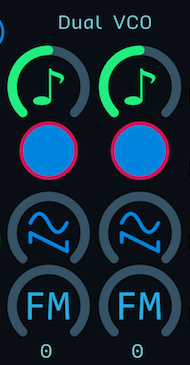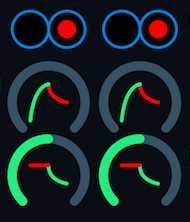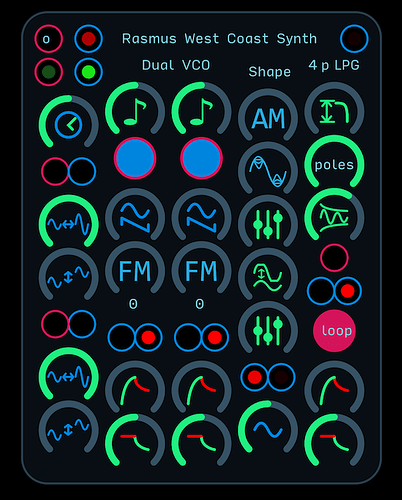Rasmus West Coast Synthesizer
This is a West Coast style synthesizer inspired by modules like @robertsyrett’s 1-Toast, which itself was inspired by the Make Noise 0-Coast.
The idea is to create something that can make all sorts of wacky wild sounds but has as few controls as possible.
This module is extensively documented inside, so make sure when you download it that you open it up and examine the signal flow. It is a lot simpler than it looks at first!
Below is a livestream that dives into the construction of the module and the thinking behind West Coast synthesis complete with an oscilloscope to show you how the oscillators behave.
Audio Path
Octave and gate input

Use an octave signal to control the pitch of the oscillators as long as they are not free running (button = red). The gate input will ping all of the internal envelopes.
Dual VCO

The Dual VCO is essentially a two operator FM synth. The primary oscillator is on the left and the modulating oscillator is on the right. The FM control at the bottom of each oscillator adjusts the amount of frequency modulation the other oscillator provides. If both FM controls are turned up, you can create a feedback loop. By pressing the button under the tune knob, you can toggle between fixed octave ratios or free tuned oscillators. You can also morph the shape of the oscillator from sine to saw as well.
Shape

The Shape section has three separate waveshapers. The AM section controls the amount of amplitude modulation applied to the primary oscillator by the modulation oscillator. Below this are the wavefolder, wavefolder mix, overdrive, and overdrive mix.
1-4p LPG

The 1-4 pole lowpass gate is a filter with a very low cutoff point - making it essentially a combination of a VCA and VCF. You can adjust the steepness of the cutoff by adjusting the number of poles. 1 pole will let in more high frequencies and 4 poles will cut them off more sharply. You can adjust the maximum modulation hight with the input attenuator. An envelope or modulation source must be attached to the input or the filter cutoff to allow sound to pass.
Audio Output

This is where the audio leaves the module - send it on to some effects! Plays nicely with delay.
Utilities
Clock and random modulation generator

The clock and random generator are there to create self-playing patches. The clock output can attach directly to the module’s gate input, which will ping all the envelopes. The random generator can also be applied to the octave input to create random pitches.
Attenuate-offsets

The Dual attenuate-offset modules are there to shape your modulation signals to get them to sit just right where you want them. Their inputs and outputs are above each pair of knobs.
A-R envelopes

These two envelopes are pinged by the gate input at the top of the module. Both normal and inverted outputs are provided. Use the normal output to modulate the LPG and use the inverted output to modulate something like the FM amount on the primary oscillator.
Sine LFO

A sine LFO to modulate anything you want. Modulating the filter cutoff knob while using an envelope to also modulate the cutoff at the LPG envelope input is a great combo. Normal and inverted outputs are provided.
A-R looping envelope

This envelope is special. When the loop button is pressed (red), it essentially becomes a triangle oscillator with a control over the rise (attack) and fall (release) times. When the button is not pressed, the envelope will loop so long as the input gate of the module is high (greater than zero). By leaving the loop button off, you can get some really nice rhythmic effects, especially when using the 50% duty cycle internal clock.
Version History
| Revision | File | Date | Notes |
|---|---|---|---|
| 1.0 | Rasmus West Coast Synth v1.0.audulus (240.4 KB) | 6/25/18 | Initial upload |
Demos
| Revision | File | Date | Notes |
|---|---|---|---|
| 1.0 | Rasmus FM Bass.audulus (268.4 KB) | 6/28/18 | A fat edgy FM bass with keyboard control. |
| 1.0 | Rasmus v1.0 - Sequence Demo.audulus (861.6 KB) | 6/25/18 | A self-playing sequencer-driven patch with drums. Relatively high-CPU, may not work on older iOS devices. |
| 1.0 | Rasmus v1.0 - Self-Patched Demo.audulus (249.1 KB) | 6/25/18 | Illustrates how you can patch the module to itself to create sound using no other external modules except an audio output. |
| 1.0 | Rasmus v1.0 - House Drum Bass Demo.audulus (886.4 KB) | 6/25/18 | Uses 3 Rasmuses to create glitch drums with a bassline - what more do you need? |



